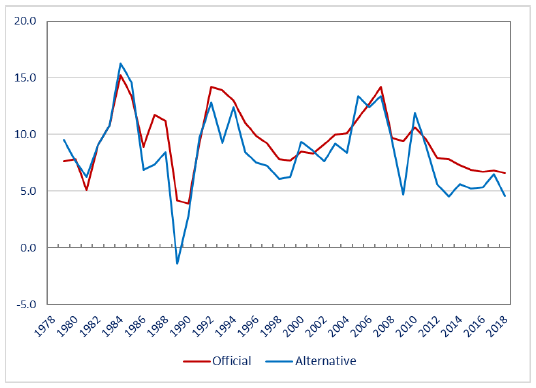| Author Name | Harry X. WU (National School of Development, Peking University / Institute of Economic Research, Hitotsubashi University) / Zhan LI (National School of Development, Peking University) |
|---|---|
| Research Project | East Asian Industrial Productivity |
| Download / Links |
This Non Technical Summary does not constitute part of the above-captioned Discussion Paper but has been prepared for the purpose of providing a bold outline of the paper, based on findings from the analysis for the paper and focusing primarily on their implications for policy. For details of the analysis, read the captioned Discussion Paper. Views expressed in this Non Technical Summary are solely those of the individual author(s), and do not necessarily represent the views of the Research Institute of Economy, Trade and Industry (RIETI).
Few would disagree that the world cannot afford to misread the real growth performance of China; nevertheless, the long-debated Chinese GDP data problem has remained unsettled. This has been an obstruction to not only government policymaking of involved countries, but to business at large. Studies using physical indicators cannot create a theory-based common ground for productive discussion between researchers and official statisticians. Instead of searching for alternative indicators, this study accepts the official nominal GDP statistics at face value and reassesses real growth by investigating the underlying price effect that is intrinsic to and coherent with the national accounts. We propose a national accounts-based approach to address this problem with reconstructed national accounts and matching prices in time series. Based on reconstructed national input-output tables in time series, we address two major biases that may have significantly distorted the official growth estimates of China, i.e., a single-deflation bias caused by discrepancies between input and output prices and an aggregation bias that is caused by a constant-price value aggregation problem. Compared to the smooth official growth rates, our procedures have exposed more volatile movements of, and greater impacts of external shocks on the Chinese economy. We show that if adjusted for alternative deflators, deflation, and aggregation methods, not only will the official growth rate decrease from 9.5 to 8.3 percent per year, but it will significantly expose the volatility of the growth, as shown in the following chart, hence providing much more useful information than the substantially smoothed official series. Furthermore, the 1.2 percentage-point downward correction also implies that China's accumulated real income over the past 40 years could be 36-percent smaller than that suggested by the official statistics.


